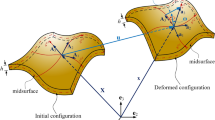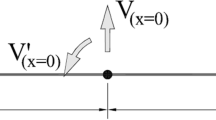Abstract
A nonlinear geometric formulation based on position and unconstrained vector is originally proposed to evaluate the local stability of thin-walled members. The Hessian is decomposed into linear and geometric equivalent installments. As the Hessian matrix exhibits a definite positive quadratic form, stability condition for large displacements requires that the Hessian matrix positivity be verified at each load small steps. This condition must be established by evaluating the smallest eigenvalue signal at the critical point imminence. The positional finite element method is formulated from a total Lagrangian reference. The mechanical system equilibrium is guaranteed by the total potential energy stationary principle. The constitutive law of Saint–Venant–Kirchhoff is obtained from the linear relationship between the second Piola–Kirchhoff stress tensor and Green–Lagrange deformation tensor. Some examples demonstrate the applicability of the methods.





















Similar content being viewed by others
References
Elishakoff I (2005) Essay on the contributors to the elastic stability theory. Meccanica 40(1):75–110
Oldfather W, Ellis C, Brown D (1933) Leonhard Euler's elastic curves. Isis 20(1):72–160. Retrieved from http://www.jstor.org/stable/224885
Koiter WT (1967) On the stability of elastic equilibrium. National Aeronautics and Space Administration, Washington
Bažant ZP (2000) Elastic, anelastic, and disintegrating structures: a conspectus of main results. ZAMM Z Angew Math Mech 80(11–12):709–732
Davis JM (2000) Recent research advances in cold-formed steel structures. J Constr Steel Res 55(1–3):267–288
Hancock GJ (2003) Cold-formed steel structures. J Constr Steel Res 59(4):473–487
Dubina D, Ungureanu V, Rondal J (2005) Numerical modelling and codification of imperfection for cold-formed steel member analysis. Steel Compos Struct 5(6):515–533
Camotim D, Basaglia C, Silvestre N (2010) GBT buckling analysis of thin-walled steel frames: a state-of-the-artreport. Thin Walled Struct 48(10–11):726–743
Schafer BW (2011) Cold-formed steel structures around the world. A review of recent advances in applications, analysis and design. Steel Constr Des Res 4(3):141–149
Sadovský Z, Kriváček J, Ivančo V, Ďuricová A (2012) Computational modelling of geometric imperfections and buckling strength of cold-formed steel. J Constr Steel Res 78:1–7
Erkmen RE, Mohareb M (2008) Buckling analysis of thin-walled open members—a finite element formulation. Thin Walled Struct 46(6):618–636
Michell AGM (1899) Elastic stability of long beams under transverse forces. Philos Mag Ser 48(292):298–309
Prandtl L (1899) Kipperscheinungen, Universität München: Doctoral dissertation
Reissner H (1904) Über die Stabilitä t der Biegung. Sitzungsber Berl Math Ges Beil Arch Math Phys III:53–56
Wagner H (1936) Torsion and buckling of open sections. In: Translated technical memorandum, NACA—National Advisory Committee for Aeronautics, vol 807
Timoshenko SP, Gere JM (1961) Theory of elastic stability, 2nd edn. McGraw-Hill, New York
Vlasov VZ (1961) Thin-walled elastic beam, English translation ed. Published for NSF and Department of Commerce by the Israel Program of Scientific Translations, Jerusalem
Ádány S, Schafer BW (2006) Buckling mode decomposition of single-branched open cross-section members via finite strip method: application and examples. Thin Walled Struct 44(5):585–600
Ádány S (2012) Global buckling of thin-walled simply supported columns: analytical solutions based on shell model. Thin Walled Struct 55:64–75
Coda HB, Paccola RR (2007) An alternative positional FEM formulation for geometrically non-linear analysis of shells: curved triangular isoparametric elements. Comput Mech 40(1):185–200
Coda HB, Paccola RR (2008) A positional FEM formulation for geometrical non-linear analysis of shells. Latin Am J Solids Struct 5:205–223
Coda HB, Paccola RR (2009) Unconstrained finite element for geometrical nonlinear dynamics of shells. Math Probl Eng 2009:32
Ciarlet P (1994) Mathematical elasticity: three-dimensional elasticity, vol 1. Elsevier, Amsterdam
Garcea G (2001) Mixed formulation in Koiter analysis of thin-walled beams. Comput Methods Appl Mech Eng 190:3369–3399. https://doi.org/10.1016/s0045-7825(00)00268-1
Reis A, Camotim D (2001) Estabilidade estrutural. McGRAW-HILL, Lisboa
Garcea G, Madeo A, Casciaro R (2012) The implicit corotational method and its use in the derivation of nonlinear structural models for beams and plates. J Mech Mater Struct 7:509–538
Acknowledgements
The authors acknowledge Federal University for Latin American Integration (UNILA) for the work environment and shared resources.
Author information
Authors and Affiliations
Corresponding author
Additional information
Publisher's Note
Springer Nature remains neutral with regard to jurisdictional claims in published maps and institutional affiliations.
Rights and permissions
About this article
Cite this article
Kzam, A.K.L., Coda, H.B. Geometrically nonlinear Hessian eigenmode decomposition for local stability analysis of thin-walled structures. Engineering with Computers 36, 1627–1641 (2020). https://doi.org/10.1007/s00366-019-00785-2
Received:
Accepted:
Published:
Issue Date:
DOI: https://doi.org/10.1007/s00366-019-00785-2




